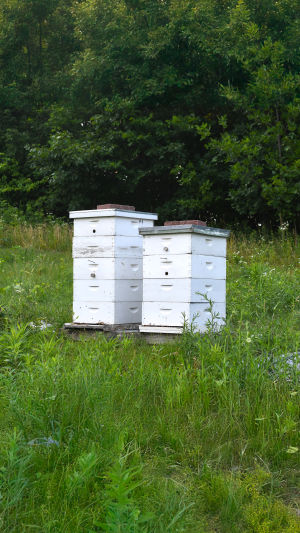If you've ever paused near a beehive, you might have noticed the constant movement: bees arriving with pollen, others fanning the air inside, some simply walking across combs.
It seems chaotic, but behind the buzzing is a finely tuned lifecycle that keeps the hive alive and thriving. Understanding this process reveals how individual bees contribute to the survival of the colony.
<h3>The Egg Stage</h3>
Every bee starts as an egg, laid by the queen in a tiny cell of the honeycomb. These eggs are about the size of a grain of rice and are carefully placed in perfect alignment. Depending on what the colony needs, the egg can develop into a worker, drone, or new queen.
The type of egg isn't determined by the egg itself but by how the larva is fed during its early days. This small beginning marks the start of a complex journey that will determine its role in the hive.
<h3>The Larva Stage</h3>
After three days, the egg hatches into a larva. At this stage, the bee looks like a small, white worm, completely dependent on worker bees for care. These nurse bees feed the larvae a special diet of royal jelly or a mixture of pollen and nectar, depending on their destined role. The larval stage lasts about six days for workers and a bit longer for drones and queens. During this time, the larva grows rapidly, increasing many times its original size, preparing for transformation.
<h3>Pupation: Transformation Begins</h3>
Once fully grown, the larva spins a cocoon around itself and enters the pupal stage. Inside the cocoon, incredible changes occur. Legs, wings, and antennae form, and the body structure shifts from a soft, crawling larva to a fully formed bee. This metamorphosis is a delicate process, and worker bees continue to cap the cell with wax, protecting the pupa until it's ready to emerge. The pupal stage is a quiet but critical time where the bee develops all the features it needs to perform its future role in the hive.
<h3>The Emergence: Worker, Drone, or Queen</h3>
After about twelve days in the pupal stage, the bee chews its way out of the wax cap. Worker bees make up the majority of the hive, taking on duties like foraging for nectar, tending to the young, cleaning, and guarding the colony. Drones exist primarily to mate with a queen, while a newly emerged queen will eventually take over egg-laying duties. Each bee's responsibilities are predetermined during the early stages but become vital to the hive's efficiency once it reaches maturity.
<h3>Roles Within the Hive</h3>
Worker bees don't stay idle. Their roles evolve as they age:
<b>Nurse bees</b> – Tend to larvae, feed them, and keep the hive clean.
<b>Foragers</b> – Leave the hive to collect nectar, pollen, and water.
<b>Guards</b> and maintenance bees – Protect the hive and repair combs.
This division of labor ensures the hive runs smoothly and can respond to challenges such as weather changes, predators, or disease.
<h3>Life Span and Hive Dynamics</h3>
Worker bees live for about six weeks during active seasons, but queens can survive several years. Drones, after mating or the end of the season, are often expelled from the hive. The hive's health depends on maintaining the right balance of these bees. Too few workers, and food collection suffers; too few queens, and the population can't renew itself. Every individual, from egg to fully grown, plays a crucial role in sustaining the colony.
<h3>Lessons From the Hive</h3>
Observing the bee lifecycle offers lessons in organization, teamwork, and resilience. Each bee's life is short but impactful, showing how coordinated effort can achieve survival on a massive scale. For humans, understanding this system also highlights the importance of bees in pollination and the broader ecosystem. Protecting their habitats and supporting biodiversity ensures that this tiny but vital workforce continues to thrive.
<h3>The Buzzing Takeaway</h3>
From the tiny egg to the fully active worker, every bee goes through a journey of growth, transformation, and contribution. The hive is not just a collection of insects; it's a living network where every member matters. Watching a beehive, listening to its soft hum, reminds us that even the smallest creatures can create systems of incredible complexity and impact.





